National flag and state flag
| Flag | Date | Use | Description |
|---|---|---|---|
 | 1906–present | Civil and state flag and ensign | Dimensions: 5:2:9 horizontally and 4:2:4 vertically. |
| Flag | Date | Use | Description |
|---|---|---|---|
 | 1906–present | Civil and state flag and ensign | Dimensions: 5:2:9 horizontally and 4:2:4 vertically. |
| Flag | Date | Use | Description |
|---|---|---|---|
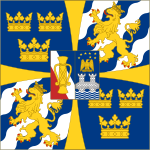 | 1943–present | Personal Command Sign of H.M. the King of Sweden (used on land). | The greater Coat of arms of Sweden, which is blue divided quarterly by a cross pattée of gold |
 | 1905–present | Royal standard of Sweden, used by H.M. The King of Sweden and H.M. The Queen of Sweden | Royal flag with the greater national coat of arms |
| | 1905–present | Royal pennant of Sweden, used by H.M. The King of Sweden above the royal flag on naval ships | Split pennant with the greater national coat of arms |
 | 1905–present | Used by other members of the Royal House | Royal flag with the lesser national coat of arms (surrounded by the insignias of the Order of the Seraphim) |
| 1905–present | Used by the heir apparent above the royal flag on naval ships | Split pennant with the lesser national coat of arms | |
 | 1905–present | Used by the Regent ad interim, when he is a non-royal | Same as the Military ensign |
 | 1844–1905 | Royal Standard of the King | |
 | 1815–1844 | Royal Standard with the Swedish Royal Arms | Naval ensign of the Union with square canton |
| Flag | Date | Use | Description |
|---|---|---|---|
 | 1905–present | Military War flag and ensign of Sweden. Also used as a naval jack. |
| Flag | Date | Use | Description |
|---|---|---|---|
 | 1972–present | Rank Flag of Admirals. | The naval ensign with four white stars in the upper hoist corner. Before 1972 the flag bore three stars (like the present flag of a Vice Admiral) |
 | 1972–present | Rank Flag of Vice Admirals. | The naval ensign with three white stars in the upper hoist corner. Before 1972 the flag bore two stars (like the present flag of a Rear Admiral) |
 | 1972–present | Rank Flag of Rear Admirals. | The naval ensign with two white stars in the upper hoist corner. Before 1972 the flag bore one star (like the present flag of a Flotilla Admiral) |
 | 2001–present | Rank Flag of Flotilla Admirals. | The naval ensign with one white star in the upper hoist corner. |
 | Broad pennant of Commodores. | Horizontally divided (1:1) forked broad pennant (5:8). | |
| | Pennant of Commanders and Lieutenant Commanders. | ||
 | Burgee of Captains, Lieutenants and Ensigns. | Vertically divided (1:1) triangular ensign (5:8). | |
| | Pennant of the Fleet Commander. | ||
| | Pennant of the Flotilla Commander. | ||
| | Pennant of the Division Commander. | ||
| | Pennant of the Senior Commander Afloat. | ||
| Flag | Date | Use | Description |
|---|---|---|---|
 | November 1905–June 1906 | National flag and civil ensign | Union badge removed |
 | 1844–1905 | National flag and civil ensign | Union badge in the upper hoist corner |
 | 1844–1905 | State flag and military ensign | Union badge in the upper hoist corner |
 | 1897–1905 | Alternate State flag | State flag to be used on state ships and at government buildings that did not fly the military ensign. Prior to 1897, used by private ships serving the Swedish Royal mail. |
 | 1844–1905 | Naval jack and diplomatic flag | The Union badge: a cross bearing the colours of both Sweden and Norway. |
 | –1844 | Civil ensign | Similar to the present national flag (slightly different colors and proportions occurred) |
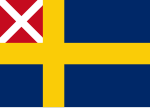 | 1818–1844 | Union civil ensign ("distant waters") | White saltire on red in the upper hoist corner. The canton in red and white represented Norway. The ensign was introduced on 26 October 1818, for use in "distant waters", i.e. beyond Cape Finisterre in North-West Spain, as an alternative to the standard Swedish civil ensign which could also be used by Norwegian ships if they wished. By Royal resolution of 17 July 1821, the saltire flag was ordered as the only Norwegian and Swedish civil ensign in "distant waters". |
 | 1815–1844 | State flag and military ensign | White saltire on red in the upper hoist corner. The canton in red and white represented Norway. |
 | 1838–1844 | Alternate state flag | Used by private ships serving the Swedish Royal mail. |
 | 1761–1813 | Military ensign of the Archipelago fleet | An all blue triple-tailed flag to be used by the Arméns flotta. |
 | mid-17th century–1815 | State flag and war ensign | Similar to the present military ensign (slightly different colors and proportions occurred) |
 | c. 1520s – c. 1620 | State flag and war ensign | Swallow-tailed flag (slightly different colors and proportions occurred) |
| Flag | Status | Use | Description |
|---|---|---|---|
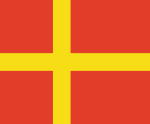 | Official [1] | The traditional province of Skåne (Scania) | |
 | Official | Skåne County (Scania) | Also a similar flag exists with blue background for Scania region |
 | Unofficial | The county of Jämtland | Jamtland (that belonged to Norway until 1645) has its own movement for the Republic of Jamtland – not a serious attempt for independence but more a touch of humor and local culture. The flag however is used in the area. |
 | Official | Jämtland County | Compare unofficial above. Jämtland modern county includes the two traditional provinces Jämtland and Härjedalen. |
 | Unofficial | The traditional province of Småland | Småland is a relatively large traditional province in the south of Sweden that today is divided in 3 administrative counties and also with 2 smaller areas outside these 3 counties. |
 | Official | Kronoberg County | Part of historical province of Småland (see above) |
 | Official | Jönköping County | Part of historical province of Småland (see above) |
 | Official | Kalmar County | Part of historical province of Småland (see above) and the island province Öland (see below). |
 | Unofficial | The historical province and island Öland outside Småland in the Baltic Sea | Öland (Swedish means "The Island Land") has a long history and different nature compared to the main land of Sweden. Öland is the second largest island in Sweden. |
 | Unofficial | The traditional province Östergötland | The blue cross relates to the two main channels and the yellow to agricultural flat areas. Not much in use. |
 | Official | Östergötland County | Compare unofficial above. |
 | Official | Västra Götaland County | Flag includes arms/flags from the 4 traditional provinces (Västergötland, Bohuslän, Dalsland and Älvsborg) that are included in this relatively newly formed regional county. |
 | Unofficial | The traditional province Västergötland | Not much in use. Also compare the previous flag above that covers the same area and more. |
 | Official | Blekinge County | The coat of arms for the traditional province of Blekinge and the administrative Blekinge county. Not much in use. |
 | Official | Halland County | There is a geographical difference between the administrative Halland county and the traditional Halland province. |
 | Official | Värmland County | There is a geographical difference between the administrative Värmland county and the traditional Värmland province. |
 | Official | Örebro County | The Örebro county includes the traditional province Närke and parts of traditional provinces of Värmland and Västmanland. The flag includes arms from these 3 counties. |
 | Official | Södermanland County | The administrative Södermanland County includes parts (southern part) of traditional Södermanland County |
 | Official | Uppsala County | The administrative Uppsala County includes parts (northern part) of traditional Uppland Province |
 | Official | Stockholm County | The administrative Stockholm County includes parts (southern part) of traditional Uppland County and (northern part) of traditional Södermanland province. the flag includes arms from these both counties and also the arms of Stockholm city. |
 | Official | Gotland County | The administrative Gotland County consists of one main and a number of smaller islands in the Baltic sea. This is the only county in Sweden that only has one municipality. |
 | Official | Västmanland County | The administrative Västmanland County includes parts of traditional Västmanland province |
 | Official | Dalarna County | This county was earlier known as Kopparbergs county and even earlier as Dalarna Province |
 | Official | Gävleborg County | Gävleborg administrative County encompasses the traditional provinces of Gästrikland and Hälsingland. |
 | Official | Västernorrland County | Västernorrland administrative county covers approximately the traditional province of Ångermanland and the traditional province of Medelpad. |
 | Official | Västerbotten County | Västerbotten administrative county covers the traditional province of Västerbotten and parts of the traditional province Swedish Lapland and traditional province of Ångermanland. |
 | Official | Norrbotten County | Norrbotten County includes the traditional province of Norrbotten and about two-thirds of the traditional province of Swedish Lapland. |
 | Unofficial [2] | Coastal area of Roslagen | Roslagen is the name of the coastal areas of Uppland province in Sweden, which also constitutes the northern part of the Stockholm archipelago. Norrtälje is sometimes named the capital city of Roslagen. |
Each official flag is based on the coat of arms for the county, see gallery, and used on buildings etc. used by respective county administration. Unofficial flags are used by private and local people.

The national flag of Denmark is red with a white Nordic cross, which means that the cross extends to the edges of the flag and the vertical part of the cross is shifted to the hoist side.

Lerum Municipality is a municipality in Västra Götaland County in western Sweden, situated just east of Gothenburg. Its seat is located in the town of Lerum.

The national flag of Sweden consists of a yellow or gold Nordic cross on a field of light blue. The Nordic cross design traditionally represents Christianity. The design and colours of the Swedish flag are believed to have been inspired by the present coat of arms of Sweden of 1442, which is blue divided quarterly by a cross pattée of gold. Blue and yellow have been used as Swedish colours at least since Magnus III's royal coat of arms of 1275.

The provinces of Sweden are historical, geographical and cultural regions. Sweden has 25 provinces; they have no administrative function but remain historical legacies and a means of cultural identification pertaining to dialects and folklore.

The national flag of Poland consists of two horizontal stripes of equal width, the upper one white and the lower one red. The two colours are defined in the Polish constitution as the national colours. A variant of the flag with the national coat of arms in the middle of the white fess is legally reserved for official use abroad and at sea. A similar flag with the addition of a white eagle is used as the naval ensign of Poland.
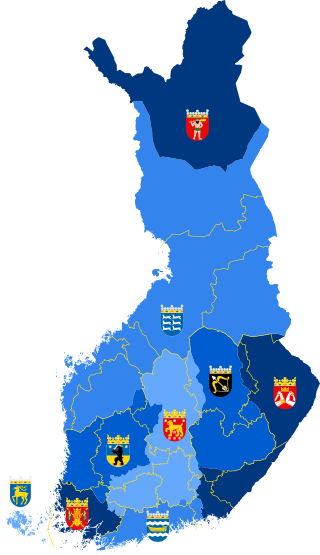
The historical provinces are former administrative or cultural areas of Finland, with origins from the slottslän of the Middle Ages. The historical provinces ceased to be administrative entities in 1634 when they were superseded by the counties, a reform which remained in force in Finland until 1997. The historical provinces remain as a tradition, but have no administrative function today.

The coat of arms of the Kingdom of Sweden is the arms of dominion of the King of Sweden. It has a greater and a lesser version.

Three Crowns is the national emblem of Sweden, present in the coat of arms of Sweden, and composed of three yellow or gilded coronets ordered two above and one below, placed on a blue background. Similar designs are found on a number of other coats of arms or flags.
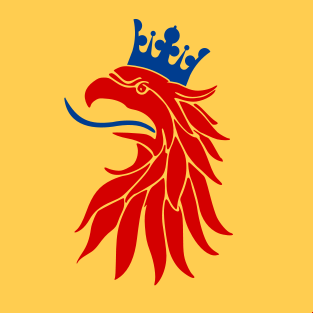
Flag of Scania refers to two different flags, of which one is a banner of the provincial coat of arms featuring a griffin head, and the other is a flag with a Scandinavian cross, the Scanian Cross Flag. They both are used as a provincial flag representing Scania, the southernmost province of Sweden.

A cross pattée, cross patty, or cross paty, also known as a cross formy or cross formée, is a type of Christian cross with arms that are narrow at the centre, and often flared in a curve or straight line shape, to be broader at the perimeter. The form appears very early in medieval art, for example in a metalwork treasure binding given to Monza Cathedral by Lombard queen Theodelinda, and the 8th-century lower cover of the Lindau Gospels in the Morgan Library. An early English example from the start of the age of heraldry proper is found in the arms of Baron Berkeley.

The Coat of arms of the Republic of Latvia was officially adopted by the Constitutional Assembly of Latvia on 15 June 1921, and entered official use starting on 19 August 1921. It was created using new national symbols, as well as elements of the coats of arms of Polish and Swedish Livonia and of the Duchy of Courland and Semigallia. Thus, the coat of arms combines symbols of Latvian national statehood, as well as symbols of its historical regions. The Latvian national coat of arms was designed by Latvian artists Vilhelms Krūmiņš and Rihards Zariņš.
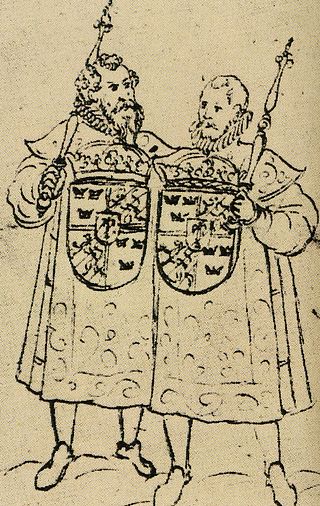
Swedish heraldry encompasses heraldic achievements in modern and historic Sweden. Swedish heraldic style is consistent with the German-Nordic heraldic tradition, noted for its multiple helmets and crests which are treated as inseparable from the shield, its repetition of colours and charges between the shield and the crest, and its scant use of heraldic furs. Because the medieval history of the Nordic countries was so closely related, their heraldic individuality developed rather late. Swedish and Finnish heraldry have a shared history prior to the Diet of Porvoo in 1809; these, together with Danish heraldry, were heavily influenced by German heraldry. Unlike the highly stylized and macaronic language of English blazon, Swedish heraldry is described in plain language, using only Swedish terminology.
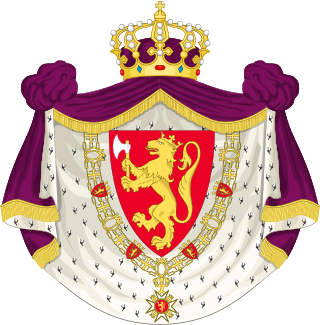
The coat of arms of Norway is the arms of dominion of King Harald V of Norway, and as such represents both the monarch and the kingdom. It depicts a standing golden lion on a red background, bearing a golden crown and axe with silver blade.

The coat of arms of Denmark has a lesser and a greater version.
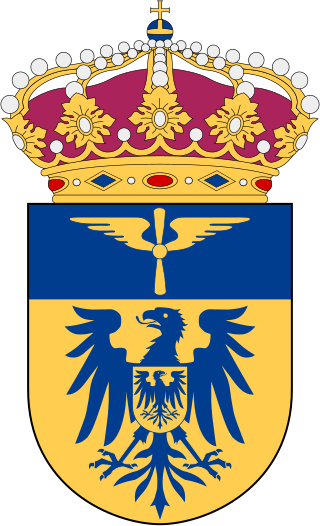
Swedish Air Force Flying School, also F 5 Ljungbyhed, or simply F 5, is a former Swedish Air Force training wing with the main base located in Ljungbyhed in southern Sweden.
This is a list of coats of arms of Ireland. In the majority of cases these are arms assigned to county councils created by the Local Government (Ireland) Act 1898 or later legislation, either by the Chief Herald of Ireland in what is now the Republic of Ireland or by the College of Arms in Northern Ireland. All but two county councils in the Republic have a coat of arms. In Northern Ireland, county councils were abolished in 1973, but the traditional arms are still occasionally used.

The East Lothian flag is the flag of the Scottish county of East Lothian (Haddingtonshire). It was registered with the Flag Institute on 13 December 2018 following its announcement at a reception hosted by the Lord Provost.